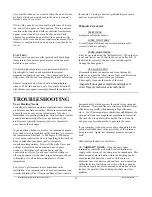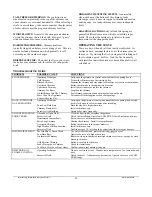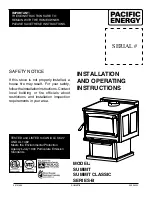
HearthStone
Quality Home Heating Products Inc
®
Starlet Model 8550
19
Care must be taken not to scratch or chip the stone. Do not
set items, which can scratch or chip the stone (or enamel
finish), on top of your stove.
Often, with use and over time, subtle earth tones of brown,
red, and yellow appear on the soapstone. This is a natural
reaction in the soapstone. Surface or hairline fractures may
appear in the stone after a stove has been used. Such
changes are normal and do not affect the operation or the
integrity of the stove and do not require replacement. If you
observe a completely broken stone, contact your dealer for
service
C
AST
I
RON
Exterior cast iron parts are either painted with black, high-
temperature stove paint or porcelainized with an enamel
finish in various colors.
Use black, high-temperature stove paint (satin black by
Stovebright) to touch up and maintain the original
appearance of painted cast iron. Use a damp sponge to
wipe clean. Dry the cast iron thoroughly to prevent rusting.
Enamel castings can be cleaned with a standard glass
cleaner. With time and use, a very fine, subtle network of
crazed lines may appear seemingly beneath the surface of
the enamel. Crazing is a natural predictable process and
does not represent a flaw.
P
ERIODIC
C
HECKLIST
EVERY WEEK
-Empty ashes from the firebox.
EVERY TWO WEEKS
-Visually inspect chimney connector and chimney for
creosote; clean accordingly.
EVERY EIGHT WEEKS
-Check door seals using the "dollar bill test." When the fire
is out and the stove cool, shut the door on a dollar bill. If
the bill pulls out easily, the door isn't sealed properly.
Change the door gasket.
AT SEASON'S END
-Dismantle chimney connector and clean thoroughly;
replace any pieces that show signs of rust or deterioration.
-Inspect and, if necessary, clean your chimney.
-Thoroughly clean out the inside of the stove.
-Inspect all door gasket material and replace if
worn, frayed, cracked or extremely hard
TROUBLESHOOTING
Your Heating Needs
Virtually all woodstove operators experience basic common
problems at one time or another. Most are correctable and
generally require only a minor adjustment of the stove,
installation, or operating technique. In cases where weather
conditions dramatically affect stove performance, the
problems are typically temporary and solve themselves
once the weather changes.
If you question whether your stove is producing adequate
heat, the best way to troubleshoot the problem is to mo nitor
the temperature of the stack. A 400 degree F (200 degree
C) stovepipe confirms the stove is supplying sufficient heat.
Keep in mind that your house itself will regulate
room/house temperatures. How well the walls, floors and
ceilings are insulated, the number and size of glass
windows, the tightness of outside doors, and the
construction or style of your house (vaulted ceilings or
other open spaces which collect large percentages of heat,
ceiling fans, etc.) all are determining factors of room
temp erature.
Your stove's performance is also dependant on its
installation. One common cause of poor performance is an
oversized chimney flue. Oversized chimney flues result in
decreased draft, which prevents the smoke from rising out
the chimney. Oversized flues are also more difficult to heat
effectively, especially when burning a high efficiency
stove. Cool flue temperatures inhibit the establishment of a
strong draft (and encourage the accumulation of creosote).
The lack of a strong draft will cause the fire to die down
and may even force the smoke to pour into the room.
If your chimney is the proper size and a strong draft is not
easily established, there is the possibility of the chimney
being too cold. Again, hot chimneys promote a stronger
draft.
Other draft guidelines are as follows:
AN
"AIRTIGHT" HOUSE:
If your home is super-
insulated or especially well sealed, the (infiltration) air
supply to the interior of the house may be inadequate. This
phenomenon of air starvation within the building can be
exacerbated if exhaust fans, such as clothes dryers,
bathroom fans or cookstove exhaust fans, are in operation
within the home. Outfitting your stove with the optional
outside air supply adaptor connected to an air duct which
leads to the outside of the building should correct this
problem.







































